As Transite, or Asbestos-containing, Roofs Come to the End of their Life Cycle, Contractors Should Know When Retrofitting Is an Option
The use of asbestos dates back thousands of years. For millennia, cultures across the globe embraced asbestos’ super-strengthening properties. Asbestos’ popularity peaked in the late 19th century during the Industrial Revolution when commercial asbestos mines sprung up across the U.S. and Canada. Before its carcinogenic properties were discovered, asbestos was used in hundreds of applications, including walls, roofs, coatings, fireplaces, shingles, insulation, pipes, furniture, paper products, automobile parts, fabrics and packaging. In the construction industry, in particular, it was considered a “super-product.” Whether mixed as a binder with cement or used as a coating on steel panels, asbestos is insulating, non-combustible, corrosion-resistant, inert, humidity-tolerant and sound absorbent.
One major application of asbestos over the past 100 years has been transite roofing panels. Asbestos was essentially used as a binder in cement slurry and then formed into profiled or flat sheets. Transite roofing panels can still be found across the country; many are still in place after 50, 60 or even 70 years of life. Because transite panels acquired asbestos’ super-strengthening properties, they made (and in some cases continue to make) ideal roofing for foundries, forges, chemical plants, paper plants, wastewater treatment plants and sewage facilities. The roofing material withstands high heat, chemical emissions, humidity and other elements emitted by these facilities that other building products could not tolerate.
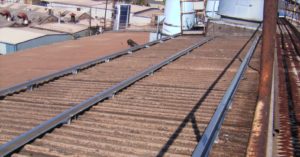
Transite roofing panels can still be found across the country; many are still in place after 50, 60 or even 70 years of life.
Despite the strength of asbestos, even transite roofs can deteriorate or require renovation. In fact, most roofing contractors have encountered or will soon encounter transite roof jobs. The job where transite is in good condition with no airborne particles may be a perfect candidate for a retrofit.
(For the purposes of simplicity, this article uniformly refers to corrugated, asbestos-containing cement roofing sheets as transite. Professionals may also encounter names like 4.2 cement asbestos or corrugated cement. It’s important to note not all corrugated cement roofing sheets contain asbestos; some manufacturers substituted wood fibers for asbestos during the height of asbestos panic in the 1980s. Few of these products successfully penetrated the market because performance did not match that of original transite.)
Leave It In Place
Contrary to popular belief, asbestos is still legally used in many commercial applications in the U.S. today, including roofing and flooring materials; in fireproofing; and in friction products, like brake shoes and clutches. With the surge of installation of transite roofs in the 1950s and 60s, the lifespan of many of these roofs’ components is just now ending. Common factors attributing to roof or structure deterioration may include longitudinal cracks along the panel highs, broken or brittle fasteners or washers, friable panel material, and/or building shifts due to expansion or contraction. Additionally, other renovations on a building may require that old roofs that are still intact be brought up to new codes.
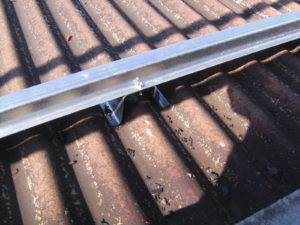
Today, a good general rule about asbestos is “leave it on if you can,” meaning it is in good condition with no airborne particles.
Professionals encountering transite roof jobs may feel confusion about how to handle asbestos-containing materials. Some may even avoid transite jobs altogether assuming they will equate to expensive asbestos-removal procedures and red tape. However, asbestos abatement (the process of removing or minimizing asbestos health hazards from a structure) can take many forms, including removal, enclosure, encapsulation or leaving the material undisturbed.
In the past, abatement through removal was the recommendation of many asbestos professionals. Traditionally, transite was replaced with fiberglass. This solution is imperfect, however, because of the expenses of asbestos removal and new fiberglass, as well as the lower heat tolerance of fiberglass-based materials. More recently, approaches have changed and several other options present themselves.
Today, a good general rule about asbestos (and in fact the position of the Washington, D.C.-based U.S. Environmental Protection Agency) is “leave it on if you can,” meaning it must be in good condition with no airborne particles. Although not always possible, when the contractor can leave the asbestos-containing material in place, asbestos should be considered friend, not foe. Regulations might prevent installation of a new asbestos transite roof, but old buildings that can keep their transite roofs in place will continue to reap the benefits of the product’s super-strengthening properties.
Retrofitting Transite
Several options present themselves to the contractor who has determined a transite roof may stay in place. When the structure’s asbestos-containing materials are at risk for becoming airborne, asbestos-abatement options, like enclosure or encapsulation, are typically best practice. Encapsulation usually entails spraying the asbestos with a sealant that will ensure fibers are kept in the material. Enclosure may involve covering the asbestos-containing material with a plaster or sheet-rock barrier.
Transite that may remain in place may be a perfect candidate for a retrofit. A growing number of contractors are gaining awareness of the traditional metal-over-metal retrofit, but far fewer are educated about transite retrofit options. The transite retrofit can be an untapped solution for many jobs that will allow the resourceful contractor to truly expand his or her business.
Some aspects of the transite retrofit are similar to that of a traditional metal-over-metal retrofit. For example, the existing roof remains in place and a new roof is mounted above it with a retrofit framing system. In both retrofits, contractors can install insulation between the new and old roofs. However, the irregularities of the transite roof preclude contractors from installing traditional retrofit systems. The shape of transite panels and variations in their installation are incompatible with a rigid overlay structure. For example, the end laps and side laps of transite roof tiles create an uneven mounting surface. In fact, in some areas where end and side laps meet, transite tiles could be stacked three high. The uniform clip heights and rigid, rollformed shape of traditional metal-over-metal retrofits simply would not enable individual transite panels to make required “direct connects” with the linear overlay member.
The unique properties of a transite roof call for a unique solution through a retrofit system that will enable installation of a flat overlay despite roof variations. This is accomplished by using clips of varying heights specifically designed for the different thicknesses of transite panels. Clip-height variations allow channels to sit above the purlins at a consistent height. To further ensure the upper level of the channels is constant, each channel is recessed on one end so it can lay flush under the un-recessed side of the next channel.
Finally, keep in mind that buildings with transite roofs almost always also have interior and exterior transite-clad walls. Walls can be retrofitted in much the same fashion as roofs, meaning contractors should consider the transite retrofit as a possible building-wide solution.
Benefits of Transite Retrofit
When installed in the proper application, a transite retrofit can benefit building owners and contractors alike. Cost-savings, preservation of strength, enhanced safety and green benefits top the list.
Cost: Asbestos removal can be extremely expensive. Out-of-pocket costs for removal, handling and disposal may be much higher than the long-term return on investment savings associated with the installation of new roofing panels. The removal process can be time-consuming and, in some instances, will disrupt operations of the building. These expenses often far exceed the cost of a retrofit. Furthermore, for buildings that require the durability of transite for industrial operations, a retrofit may allow owners to choose a less expensive new roof panel that is not required to withstand the heat, moisture or other elements of internal operations.
Strength and Durability: It’s no secret asbestos panels are strong and durable. That’s why buildings containing them are still standing nationwide. When building owners can continue to benefit from this strength by keeping their transite roof in place, they should! Some transite retrofits may even increase negative and positive loads of the new roof system. By using an overlay system, positive loads, like snow weight, are held away from the existing transite panels. By using a “deflection limiter” system with sturdy structural attachments between the existing purlins, the new roof system may have the ability to meet higher load requirements imposed by new building codes. Installation of deflection limiters allows clips to be spaced as required in critical edge and corner zones.
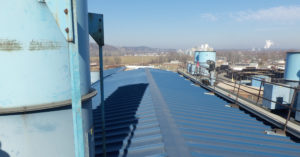
Some aspects of the transite retrofit are similar to that of a traditional metal-over-metal retrofit.
Safety: The EPA generally prefers to see asbestos roofing materials repaired or covered rather than torn off. Health risks for workers and the public are minimized when asbestos remains intact and in place.
Environmentally Friendly: Consider the green option of repurposing old asbestos buildings rather than tearing them down. While many of the old industrial purposes for large buildings may be disappearing or changing, these structures can still be used for decades for other purposes. Add a new roof and some insulation and your chemical plant becomes something totally new. Also, landfill disposal of old asbestos-containing materials presents a health risk for this and future generations.
Safety First
Retrofitting over asbestos-containing transite can be a wonderful option for building owners and contractors. But because asbestos is involved, you can’t be too careful. An asbestos assessment by a properly certified inspector will help guide your abatement plan by confirming the presence of asbestos and determining what, if any, impact the material is having on the structure and environment. Also remember that local, state and federal codes regulate renovations involving asbestos-containing materials. Best practice, safety consideration and the law require that contractors check these codes before beginning renovations, so ensure your asbestos professional is properly certified and ask lots of questions.
PHOTOS: Top Hat Framing Systems, www.tophatframing.com

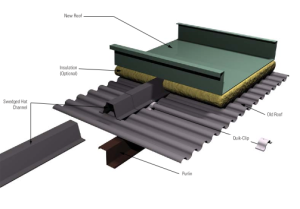
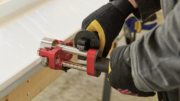


Be the first to comment on "Transite Roofing: Friend or Foe?"